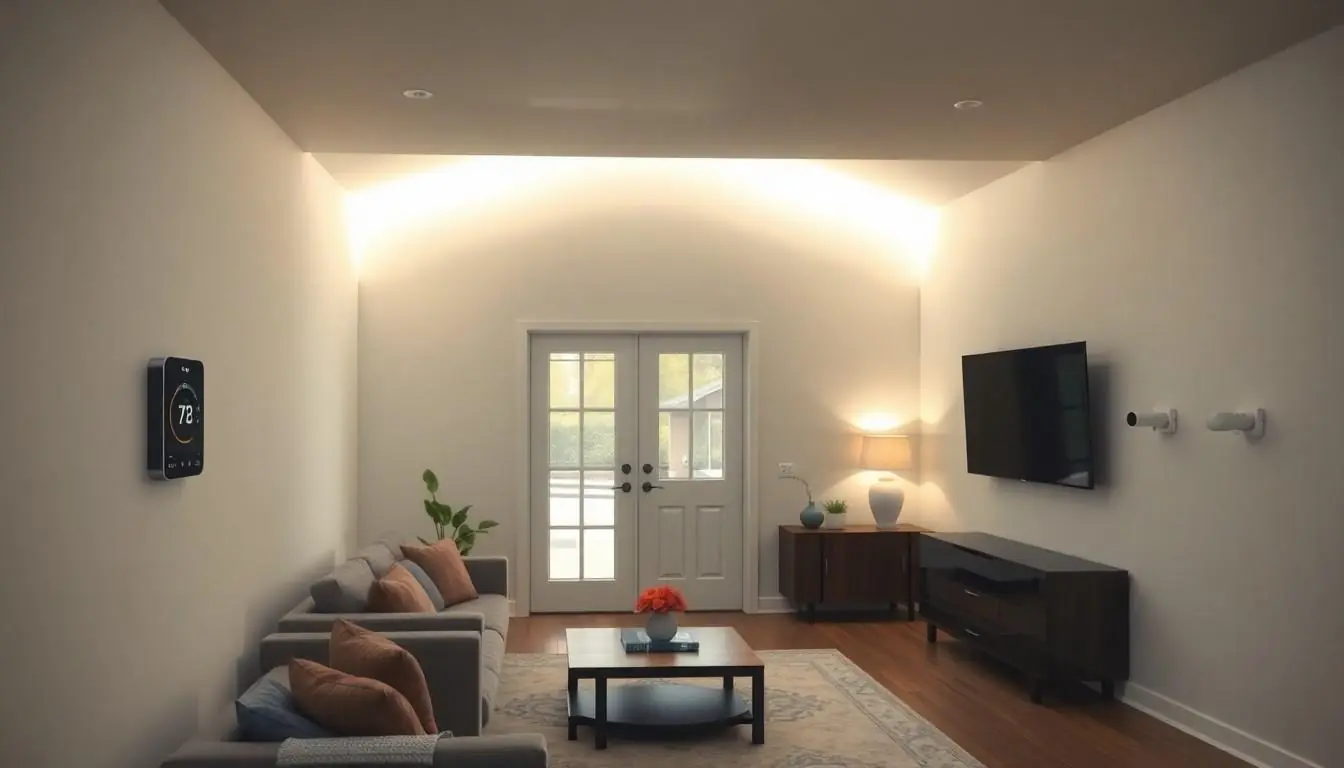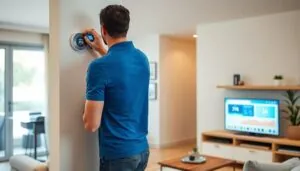Imagine walking into your home and having the lights greet you like an overly enthusiastic puppy. Building a smart home isn’t just about convenience; it’s about transforming everyday living into a futuristic experience that even The Jetsons would envy. With smart devices at your fingertips, you can control everything from your thermostat to your coffee maker, all while lounging on the couch in your pajamas.
But let’s be real: navigating the world of smart home technology can feel like trying to solve a Rubik’s Cube blindfolded. With so many options, it’s easy to feel overwhelmed. Fear not! This guide will help demystify the process, making it as smooth as your favorite playlist on a lazy Sunday. Get ready to turn your home into a high-tech haven that not only impresses guests but also makes life a whole lot easier.
Table of Contents
ToggleUnderstanding Smart Homes
Smart homes utilize technology to enhance daily living. This integration allows for seamless control of various devices, providing an advanced user experience.
Definition of Smart Home
A smart home refers to a residence equipped with smart devices that connect via the internet. It includes appliances like lights, locks, and thermostats, which respond to user commands. These devices can be controlled remotely through smartphones or voice assistants. Each device communicates within the network, facilitating automation. Homeowners can schedule routines or create scenarios for different times of the day.
Benefits of Smart Home Technology
Smart home technology offers numerous advantages. Convenience tops the list, as it allows users to manage devices with ease. Energy efficiency becomes another key benefit, with smart thermostats adjusting temperatures based on habits. Enhanced security stands out with smart locks and cameras monitoring homes in real time. Comfort increases through personalized settings tailored to individual preferences. Finally, these technologies promote accessibility, aiding individuals with disabilities in managing their environments.
Essential Components of a Smart Home

Smart homes consist of various interconnected devices that provide enhanced functionality and convenience. Key components include smart lighting, security systems, and thermostats, each playing a significant role in creating an integrated environment.
Smart Lighting Solutions
Smart lighting systems offer customizable and efficient lighting options. These systems enable users to adjust brightness, color, and timing remotely through smartphones or voice commands. For instance, motion sensors activate lights when someone enters a room. Additionally, scheduling capabilities allow automatic lighting changes based on user preferences. Energy-saving features optimize electricity consumption, reducing utility bills while maintaining aesthetics. Popular products include Philips Hue and LIFX, which provide extensive compatibility with other smart devices.
Smart Security Systems
Smart security systems significantly enhance home protection. These solutions include cameras, doorbell cameras, and smart locks that monitor homes in real-time. Video surveillance features allow homeowners to check live feeds from anywhere. Alerts notify users of potential security breaches through apps and text messages. Integration with other smart devices enables automated responses, such as turning on lights when motion is detected. Brands like Ring and Arlo provide robust options tailored for various security needs.
Smart Thermostats
Smart thermostats promote energy efficiency and personalized climate control. Users can remotely adjust temperature settings through apps or voice commands. Smart learning capabilities enable these devices to adapt to individual schedules by analyzing usage patterns. Energy reports provide insights into consumption, helping reduce costs. Brands like Nest and Ecobee offer features like geofencing, which adjusts settings based on users’ locations. These advancements create more comfortable living spaces while optimizing energy use.
Planning Your Smart Home
Creating a smart home involves careful planning. This stage ensures the technology fits seamlessly into daily living.
Assessing Your Needs
Identifying specific needs forms the foundation of a smart home setup. Users should consider which devices enhance their routines effectively. Prioritizing security, for instance, may lead to investing in smart locks and cameras. Individuals who frequently adjust lighting might find smart bulbs beneficial. Assessing energy usage can help decide on smart thermostats, optimizing comfort and savings. Understanding personal preferences and daily habits serves as a guiding factor, leading to a tailored smart home experience.
Budget Considerations
Establishing a budget is crucial before diving into smart home technology. Setting a clear financial limit helps maintain focus on essential devices. Researching various brands and models allows users to compare costs and features. Many smart devices offer various price ranges, which influences decisions. Allocating funds to prioritize high-impact items ensures maximum benefit. Additionally, considering installation costs and ongoing expenses, like subscriptions, rounds out a comprehensive budget approach. Balancing quality with affordability ultimately enhances the smart home journey.
Popular Smart Home Ecosystems
Smart home ecosystems provide a foundation for managing devices and maximizing efficiency. Three major platforms dominate this landscape: Amazon Alexa, Google Home, and Apple HomeKit.
Amazon Alexa
Amazon Alexa stands out for its extensive compatibility with smart devices. This platform supports a vast array of third-party products, allowing integration across many categories, from lights to security cameras. Users enjoy voice control through Echo devices, simplifying the management of smart home functions. Regular updates and skills ensure Alexa remains relevant, adding new features and expanding its capabilities. Additionally, routines enable users to automate daily tasks, enhancing convenience and efficiency.
Google Home
Google Home excels in smart home management through Google Assistant. Integrations span numerous devices, making it easy to connect different brands. Voice commands activate features quickly while maintaining user-friendly navigation. The platform leverages Google’s search capabilities, allowing for contextual responses and tailored suggestions. Chromecast support enables seamless media control across devices, providing entertainment and convenience. Regular enhancements make Google Home an appealing option for users seeking a cohesive smart home experience.
Apple HomeKit
Apple HomeKit secures its place with a focus on privacy and security. This ecosystem operates exclusively with HomeKit-compatible devices, ensuring a standardized level of integration. Users benefit from the Home app, which centralizes control of all connected devices. Siri voice command support streamlines operations while enhancing the user experience. Apple’s strict privacy policies guarantee secure data handling, appealing to security-conscious users. This platform integrates seamlessly with other Apple products, fostering a unified technology environment.
Installation and Integration
Setting up a smart home requires thoughtful installation and integration of devices. Both DIY and professional options exist to streamline this process.
DIY Smart Home Setup
Many individuals prefer a DIY smart home setup for its cost-effectiveness and flexibility. Users often start by selecting a base ecosystem like Amazon Alexa or Google Home. Smart devices such as lights, cameras, and thermostats easily connect to these platforms, enhancing control. After purchasing devices, the next step involves downloading necessary apps to manage them efficiently. Installation usually includes following the instructions provided by each device manufacturer. Connecting the smart devices to the home’s Wi-Fi network allows seamless communication and automation. Community forums and online tutorials offer extensive support for troubleshooting common issues.
Professional Installation Options
For those seeking a hands-free approach, professional installation options provide specialized guidance. Certified technicians often assess the home’s layout before choosing compatible smart solutions. This evaluation maximizes efficiency in device placement and integration. Professionals handle the installation process, ensuring each device connects correctly to the chosen ecosystem. Additionally, they can provide training on how to use and manage the installed systems. Many companies offer after-installation support for maintenance and upgrades, enhancing the long-term functionality of smart technology. Investing in professional installation can lead to a smoother transition into a fully integrated smart home experience.
Embracing smart home technology can transform daily living into a more convenient and efficient experience. By carefully planning and selecting the right devices, homeowners can create a tailored environment that meets their unique needs. With a variety of ecosystems available, integrating smart devices becomes a straightforward process.
Whether opting for a DIY approach or seeking professional installation, the journey to a fully connected home is within reach. As technology continues to evolve, the possibilities for enhancing comfort, security, and energy efficiency will only expand. Building a smart home isn’t just about gadgets; it’s about improving quality of life and enjoying the benefits of modern living.


